 Author interview: Dennis Blanchard’s (K1YPP) “Three Hundred Zeroes: Lessons of the Heart on the Appalachian Trail”
Author interview: Dennis Blanchard’s (K1YPP) “Three Hundred Zeroes: Lessons of the Heart on the Appalachian Trail”
This year, at the Four Days in May (FDiM) Dayton QRP gathering, I had the pleasure of meeting Dennis Blanchard (K1YPP) and his wife, Jane, as Blanchard signed copies of his book, Three Hundred Zeroes: Lessons of the Heart on the Appalachian Trail. I had previously heard about Blanchard’s book, and it was great meeting the author in person. Both he and his wife were most friendly, and I instantly felt a connection–after all, he is a fellow QRPer!
As a result of this meeting, I recently decided to purchased a copy of Three Hundred Zeroes on my Kindle eBook reader. Though I’ve always been a fan of turning pages on a traditional book, the eReader does afford one instant gratification, as you can order it on-the-go and start reading immediately. And that’s exactly what I did…
The result? I’m very glad I took the time to read Blanchard’s Three Hundred Zeros. Though I don’t like to spend much time away from my young family at present, I’ve always thought it would be a wonderful challenge and adventure to through-hike the AT (Appalachian Trail); reading this book was a vicarious opportunity to do so. Indeed, my favorite trail, the BT–the Bartram Trail, which follows the path of early American naturalist and explorer William Bartram–which I hike when I can, and whose NC chapter I’ve served as a board member for nearly 10 years now, parallels the AT at different points. So the temptation to hike (and QRP, of course) continues.
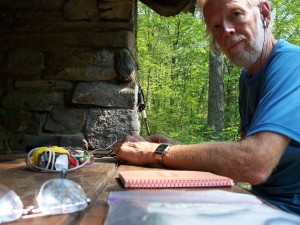
“This photo was taken in NJ. Shortly after I took these photos, and walked down the trail about a 100 feet, a bear came over to check the table to see if I had left anything.” (Photo: K1YPP)
Blanchard’s book gives me hope. Three Hundred Zeroes is a well-documented, informative, and–despite his truly serious heart condition–often humorous journal-style account of his successful thru-hike of this 2176 mile trail. His writing style is very informal and likeable, focusing on the many personal interactions that make the trail hiker’s experience unique, and interweaving his day-to-day accounts with trail lore and history.
In contrast with the arduous journey Bill Bryson describes his well-known (and hilarious) book, A Walk in the Woods, in Three Hundred Zeros Blanchard calmly and routinely deals with misadventures and hair-raising encounters with wildlife, rolling with the punches and somehow emerging unscathed. He describes the journey as “long stretches of boredom, punctuated by brief moments of excitement” in the lively and unpredictable form of bears, mice, snakes, and even other hikers, to some degree. Blanchard was obviously a great hiking companion, thus rarely hiked alone–no doubt, other hikers sought his company.
With QRP in mind, I had a few questions for Blanchard after reading his book. He has kindly taken the time to respond to QRPer.com‘s questions, as follows.
QRPer: I always thought that the AT would be a lonely place, but your book certainly changed my mind. Were there many stretches of trail where you were completely alone while trekking or camping at night?
Blanchard: There were times when I was alone for extended periods. However, “alone” is a relative term. Throughout the day I would encounter other hikers going in the other direction, or people that were slower or faster than I. In 180 days on the trail, I think I had three nights when I camped alone.
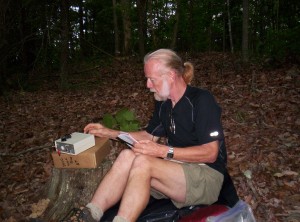
“2007-Damascus, VA was where I operated Field Day in 2007. It was shortly after this that I left the trail for the heart surgery.” (Photo: K1YPP)
QRPer: What was your favorite stretch of trail?
Blanchard: That’s difficult to answer…The trail is so varied and weather can change one’s views of any section. For me, it was a coin toss between the New Hampshire White Mountains and the 100 Mile Wilderness in Maine. The remoteness of both areas was just so spectacular. Of course the high altitudes made for great antenna opportunities as well.
QRPer: Did you bring a radio to listen to local AM/FM or shortwave?
Blanchard: For most of the hike, I carried a Yaesu VX-1R 2/440 handi-talkie. I think I used it about three times on two-meters. In a few situations, such as up in the White Mountains, I used the VX-1R to tune in NOAA for weather news. It also has AM/FM and on a few very rare occasions, I tuned into local stations for news. Would I carry it again? I don’t know. It is wise to have something for emergencies, and the radio wasn’t too big or heavy, but it was extra weight.
QRPer: Specifically, what ham gear did you take with you? Do you have a photo?
Blanchard:As noted in the book, I did carry a home-brewed 80/40 meter CW rig for the first 600 miles. For the rest of the hike I carried Steve Weber’s ATS-3A. The radio was powered by six Energizer disposable lithiums, in a home-brewed battery pack. The pack could also charge my cell phone and power the 2-meter VX-1R radio. I used a 51 foot random wire for the antenna and some counterpoise wire, usually about 15 feet. Altogether, the gear weighed around two pounds.
QRPer: If you were to do the hike again, would you take the same equipment?
Blanchard: I’m not certain I would carry the VX-1R again. I didn’t use it much and it is extra weight. However, the NOAA weather, and 2-meter capability could prove extremely useful in an emergency.
QRPer:What was it like coming back off the trail once you completed it? Any especially notable things about how you perceived the world around you? Did it change you? Any culture shock?
Blanchard: The only real “culture shock” was riding in automobiles. Everything seemed to move so quickly. I much more enjoy walking and biking now. I would be happy if I never had to drive again.
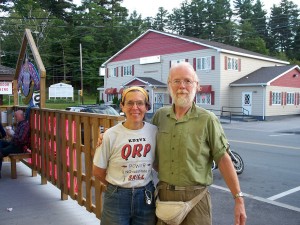
“KD2VX, Kathy, was the trail angel that helped out with my hike up in New Hampshire. She is a QRP fan.” (Photo: K1YPP)
QRPer: How many other hams did you meet on the AT who were either through-hiking the AT, or hiking sections?
Blanchard: Since we [hikers] don’t wear being a “ham” on our sleeve[s], I can’t really say how many hams I encountered. The few that I was aware of were mostly section hiking. One benefit of setting up my QRP station along the way was public visibility for ham radio. On a number of occasions I inspired my fellow hikers to look into ham radio when they returned home. I’ve even had a few readers of the book write me to tell me they went off and got a ham license based on inspiration from the book.
QRPer: If any other QRPers are inspired by your story, and are thinking about hiking the entire AT, how much money should they budget for such an adventure? Based on what I read, there are a number of budgetary considerations for shuttles, food, gear, and the like.
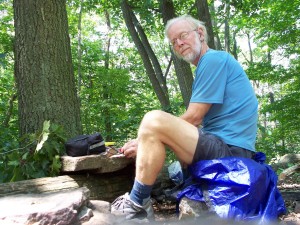
“Duncannon, PA was were I operated Field Day. The station table was a few rocks I moved around.” (Photo: K1YPP)
Blanchard: The answer to this question depends on how many “creature comforts” one wishes. Hiking as I did, with stops along the way about every 5-10 days, can cost about $1-$3 a mile. Those on a tight budget could do it for much less, and those that enjoy getting to hotels and eating in fancier places could spend more. Most of the shuttles were really not that expensive, at least those that cater specifically to hikers. The hostels are a real bargain, compared to standard hotels, but one may have to tolerate annoyances, such as snoring and people coming and going at unusual hours. If you’re a light sleeper, this could be an issue.
QRPer: On zero days [based on your descriptions] it seems like hikers simply stuff themselves with food. I’m really curious what you typically ate on the trail?
Blanchard:The short answer is: I ate everything. I’m not fussy, and don’t have any diet limitations. If someone is diabetic, or vegetarian, it is still possible to undertake such a hike, it just might require more preparation. My typical day was a few Pop Tarts first thing in the morning, or hot oatmeal on cold days, followed by an on-trail mid-morning snack, such as a Snickers Bars or trail mix.
Lunch was usually something that didn’t need cooking. Roll-up tortillas, or bagels with peanut butter won out most of the time. In the colder weather, bagels and cream cheese was a favorite. Gatorade powder mix, or hot chocolate in cold weather, was my favorite drink for lunch.
The evening meal was usually a pasta-based affair, or couscous. I really preferred the couscous; it is very light to carry, needs very little energy to cook, and is loaded with nutrients. I would usually stir in some dried vegetables with it, or dried meat. As a side I would carry a dried sausage, such as pepperoni, which could also serve as a snack for lunch. I usually carried some desert items as well, such as cookies or dried fruit. Of course energy bars would supplement all of this along the way. Many hikers preferred candy bars, but I tried to avoid them in the warmer weather since they melt.
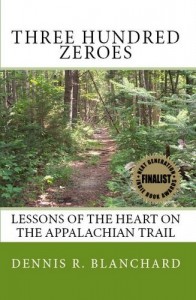 Overall, even though the diet sounds bland, it wasn’t bad. Of course, whenever we hit a town, I would stuff on everything in sight. I actually did eat well, but couldn’t find enough calories to maintain my weight. I ended up losing 35 pounds at the end of the hike and looked like a refugee.
Overall, even though the diet sounds bland, it wasn’t bad. Of course, whenever we hit a town, I would stuff on everything in sight. I actually did eat well, but couldn’t find enough calories to maintain my weight. I ended up losing 35 pounds at the end of the hike and looked like a refugee.
Well, Dennis–all I can say is that I hope you’ve gained back some of those lost pounds, continue to be in good heart-health, and are able to enjoy a little QRP on your forthcoming hikes. Thanks very much for taking the time to answer our questions; we wish you the very best!
You can purchase Dennis’ book from Amazon.com or Barnes and Noble and visit his website at threehundredzeroes.com.

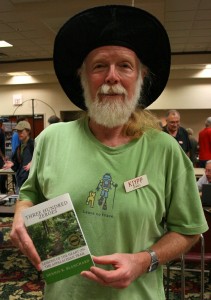
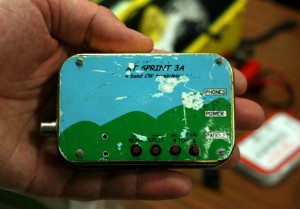
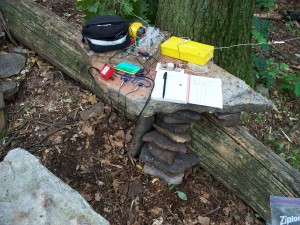













Thanks so much for posting my vic on your blog!I am still pgiglung away at the feature length version of the JMT Documentary. Keep an eye out for it this summer sometime.Happy Trails to you!-Pete